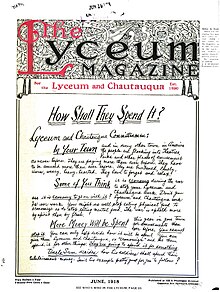| This article includes a list of references, related reading, or external links, but its sources remain unclear because it lacks inline citations. Please help improve this article by introducing more precise citations. (November 2022) (Learn how and when to remove this message) |

The lyceum movement was a loose collection of adult education programs that flourished in the mid-19th century in the United States, particularly in the Northeast and Midwest, that were inspired by the classical Lyceum. Some of these organizations lasted until the early 20th century.
Purpose
The lyceums, mechanics’ institutes, and agriculture organizations like The Grange flourished in the U.S. before and after the Civil War. They were important in the development of adult education in America. During this period hundreds of informal associations were established for the purpose of improving the social, intellectual, and moral fabric of society. The lyceum movement featured lectures, dramatic performances, class instructions, and debates, by noted lecturers, entertainers and readers. They would travel the "lyceum circuit," going from town to town or state to state to entertain, speak, or debate in a variety of locations, never staying in one place for too long. Their appearances were open to the public, which caused them to contribute significantly to the education of the adult American in the 19th century.
Origins
The first American lyceum, "Millbury Branch Number 1 of the American Lyceum," was founded by Josiah Holbrook in 1826. Holbrook was a traveling lecturer and teacher who believed that education was a lifelong experience, and intended to create a National American Lyceum organization that would oversee this method of teaching. Other educators adopted the lyceum format but were not interested in organizing, so this idea was ultimately dropped.
Peak of the movement
The Lyceum Movement reached the peak of its popularity in the antebellum era. Public Lyceums were set up around the country, as far south as Florida and west as Detroit, Michigan. Transcendentalists such as Ralph Waldo Emerson and Henry David Thoreau endorsed the movement and gave speeches at many local lyceums. As a young man, Abraham Lincoln gave a speech to a Lyceum in Springfield, Illinois.
Lyceum as entertainment
After the American Civil War, lyceums were increasingly used as a venue for travelling entertainers, such as vaudeville and minstrel shows. They were also still used for public speeches and lectures. Notable public figures such as Susan B. Anthony, Elizabeth Cady Stanton, Victoria Woodhull, Anna Dickinson, Josiah Gilbert Holland, Mark Twain, and William Lloyd Garrison, all spoke at lyceums in the late 19th century.
See also
- Lyceum
- Lyceum (Alexandria, Virginia)
- The Lyceum (Mississippi)
- Oregon Lyceum
- Chautauqua
- Lecture circuit
- Nipo T. Strongheart
References
- Cecil B. Hayes (1932). The American Lyceum: Its History and Contribution to Education (PDF) (Report). United States Department of the Interior. p. vii-viii. Retrieved 24 November 2022.
- "Abraham Lincoln's Lyceum Address". Showcase.netins.net. Archived from the original on 2012-07-21. Retrieved 2012-07-23.
- Bode, The American Lyceum: Town Meeting
- Goldsmith, Barbara, Other Powers, Alfred A. Knopf, Inc., 1998.
- Stevens, "Science, Culture, and Morality." 69-83
- Strother, French (September 1912). "The Great American Forum: Chautauqua and the Chautauquas in Summer and the Lyceum In Winter". The World's Work: A History of Our Time. XXIV: 551–564. Retrieved 2009-07-10.
Further reading
- Ray, Angela G. The Lyceum and Public Culture in the Nineteenth Century United States. E. Lansing: Michigan State University Press, 2005.
- Powell, E. P., “The Rise and Decline of the New England Lyceum”, The New England Magazine, Vol. 17, No. 6 (February 1895), pp. 730–739.
- A.A. Wright, ed. (1906), Who's who in the lyceum, Philadelphia: Pearson brothers, OL 24162319M
- Wright, Tom F., ed. The Cosmopolitan Lyceum: lecture culture and the globe in nineteenth-century America. Amherst: University of Massachusetts Press, 2013.